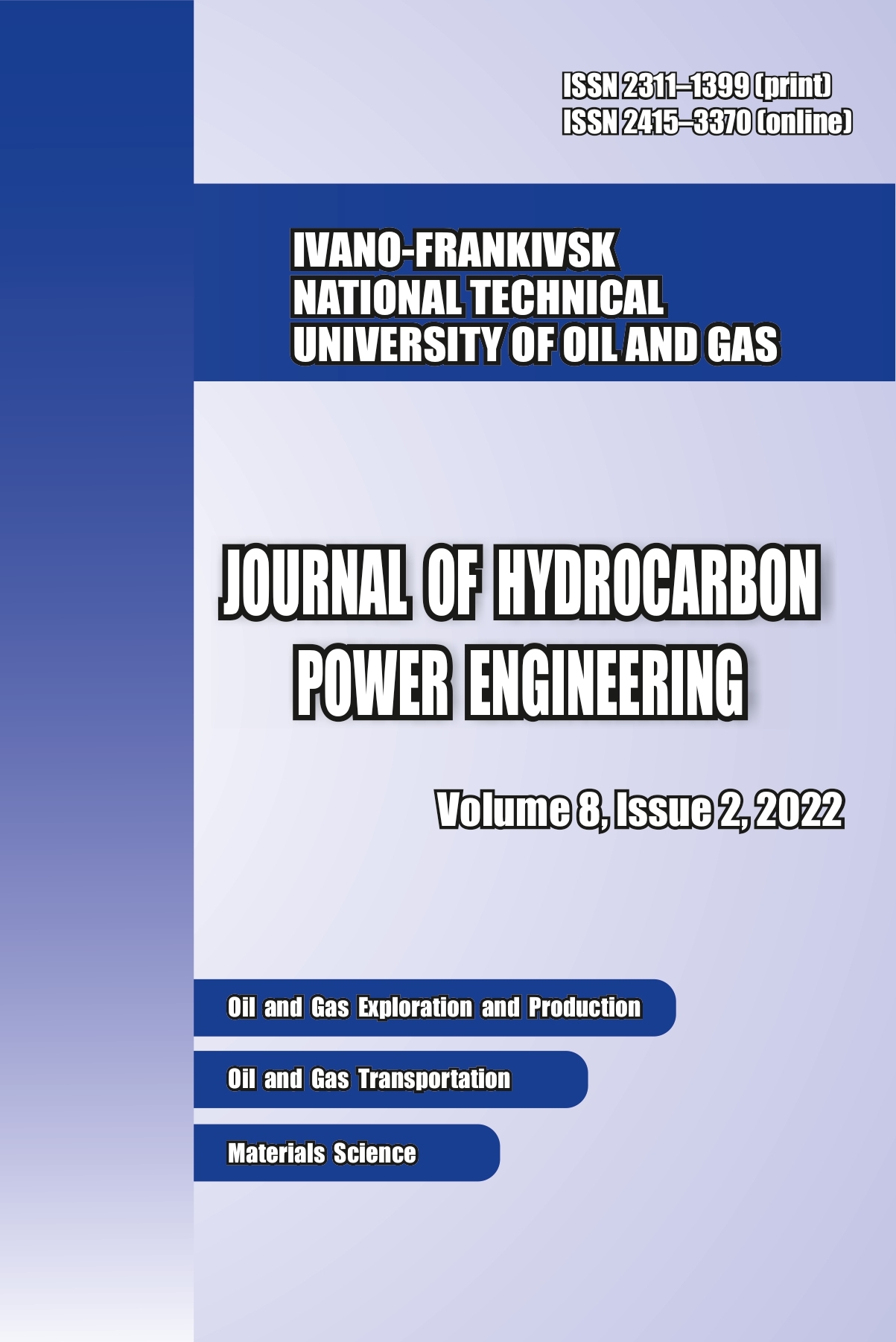Технологія формування модифікованих епоксикомпозитних покриттів для захисту конструкцій нафтогазового комплексу
DOI:
https://doi.org/10.31471/2311-1399-2022-2(18)-53-61Ключові слова:
адгезійна міцність, полівінілхлорид, порошок титан (ІV) оксиду, циклогексанон.Анотація
В роботі визначено адгезійну міцність сформованих за різними технологічними режимами
епоксикомпозитних покриттів, які містять дрібнодисперсний порошок оксиду титану (TiO2) та розчинений в
циклогексаноні полівінілхлорид. Найвищі значення адгезійної міцності отримано для двошарових
покриттів, в яких нижній шар (адгезійний) містить порошок хром (ІІІ) оксиду, а верхній (експлуатаційний)
шар складається з модифікованого епоксиполімерного в’яжучого наповненого апретованим порошком титан
(IV) оксиду. Оптимізовано режими формування епоксикомпозитних покриттів, для яких отримано вищі
значення адгезійної міцності. Вищі значення ударної в’язкості на 40–45 % отримано для епоксикомпозитів,
для яких технологія формування включала витримку порошку полівінілхлориду в циклогексаноні з
наступним введенням порошку TiO2. Це забезпечує насичення поверхні частинок наповнювача
макромолекулами полівінілхлориду, які утворюють додаткові хімічні зв’язки та сприймають динамічні
навантаження. Практичне призначення розробленого епоксикомпозитного покриття полягає у захисті
конструкцій, обладнання та устаткування нафтогазового комплексу від впливу гідроабразивних потоків під
час транспортування нафти та нафтопродуктів, що являє собою комплексний вплив агресивних речовин,
води та температури, які спричиняють появу ділянок руйнування на внутрішніх поверхнях трубопроводів та
обладнання. Складність нанесення епоксикомпозитних покриттів, що містять апретований
дрібнодисперсний порошок титан (IV) оксиду полягає в тому, що відбувається коагуляція частинок
порошку. Застосування циклогексанону підвищує технологічність композиції шляхом зменшення здатності
частинок порошку до коагуляції.
Завантаження
Посилання
Ke Xi, Hao Wu, Chilou Zhou, Ziyang Qi, Kailong
Yang & Ricky KY Fu, [et al.] 2022, ‘Improved corrosion and
wear resistance of micro-arc oxidation coatings on the 2024
aluminum alloy by incorporation of quasi-two-dimensional
sericite microplates’, Applied Surface Science, vol. 585,
Baig, MA & Samad, MA 2021, ‘EpoxyEpoxy
CompositeEpoxy Hybrid Composite Coatings for Tribological
Applications — A Review’, Polymers, vol. 2(13), p. 179.
Hongyu Wei, Jun Xia, Wanlin Zhou, Laishui Zhou,
Ghulam Hussain, Qin Li & Kostya (Ken) Ostrikov 2020,
‘Adhesion and cohesion of epoxy-based industrial composite
coatings’, Composites Part B: Engineering, vol. 193, 108035.
Dan Liu, Wenjie Zhao, Shuan Liu, Qihong Cen &
Qunji Xue 2016, ‘Comparative tribological and corrosion
resistance properties of epoxy composite coatings reinforced
with functionalized fullerene C60 and graphene’, Surface and
Coatings Technology, vol. 286, pp. 354–364.
Chandrabhan Verma, Lukman O. Olasunkanmi,
Ekemini D. Akpan, M.A. Quraishi, O. Dagdag, M. El Gouri,
El-Sayed M. Sherif & Eno E. Ebenso 2020, ‘Epoxy resins as
anticorrosive polymeric materials: A review’, Reactive and
Functional Polymers, vol. 156, 104741.
Yongxing Zhang, Min Zhao, Jiaoxia Zhang, Qian
Shao, Jianfeng Li, Hang Li, Bo Lin, Meiyan Yu, Shougang
Chen & Zhanhu Guo 2018, ‘Excellent corrosion protection
performance of epoxy composite coatings filled with silane
functionalized silicon nitride’, Journal of Polymer Research,
vol. 25, p. 130.
Yan Hao, Xiying Zhou, Jiajia Shao, Yukun Zhu.
, The influence of multiple fillers on friction and wear
behavior of epoxy composite coatings, Surface and Coatings
Technology, vol. 362, p. 213–219.
Jiaoxia Zhang, Weirui Zhang, Liping Wei, Liuyue Pu,
Jianping Liu, Hu Liu, Yingchun Li, Jincheng Fan, Tao Ding &
Zhanhu Guo 2019, ‘Alternating Multilayer Structural Epoxy
Composite Coating for Corrosion Protection of Steel’,
Macromolecular Materials and Engineering, vol. 304, iss. 12,
Balázs Jakab, Ileana Panaitescu & Norbert
Gamsjäger 2021, ‘The action of fillers in the enhancement of
the tribological performance of epoxy composite coatings’,
Polymer Testing, vol. 100, 107243.
Savchuk, P, Matrunchyk, D, Kashytskyi, V,
Sadova, O & Moroz, I 2019, ‘The influence of metal oxide
powders on the physical and mechanical properties of epoxy
composites for the protection of constructions made of
aluminum alloys’, Ukrainian Journal of Mechanical
Engineering and Materials Science, vol. 5, no. 2, pp. 16–24.
Savchuk, P, Matrunchyk, D, Kashytskyi, V,
Sadova, O & Moroz, I 2020, ‘The influence of ultrasonic
treatment on the mechanical properties of epoxy composites
modified with fine powder of titanium oxide’, Proceedings of
the XXII International Scientific and Practical Conference
«International Trends in Science and Technology» (Warsaw,
Poland), vol. 1, pp. 13–20.
Myroniuk, ІF, Cheliadyn, VL, Кotsiubynskyi, VО
& Мyroniuk, LІ 2011, ‘Structure and morphology of TiO2
particles, obtained by liquid phase hydrolysis of TiCl4’, Solid
state physics and chemistry, vol. 12, iss. 2, pp. 416–427.
##submission.downloads##
Опубліковано
Як цитувати
Номер
Розділ
Ліцензія
Авторське право


.png)





.png)
